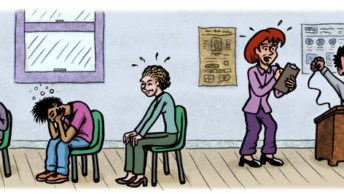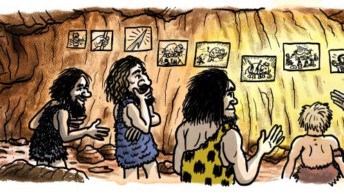Yesterday morning I spent an enlightening hour hosting Ruth Ellison in our Campfire chatroom for a session on Customer Journey Mapping. It was one of the most popular sessions that I’ve run to date, and Ruth’s form was fantastic. The questions came thick and fast but she didn’t let it phase her!
Ruth is a Principal user experience designer working at PwC’s Experience Centre, in Canberra, Australia.
She is extremely passionate about creating accessible and inclusive user experiences and is fascinated by the way humans interact with each other and with web and computer systems.
If you didn’t make the session because you didn’t know about it, make sure you join our community to get updates of upcoming sessions. If you’re interested in seeing what we discussed, or you want to revisit your own questions, here is a full transcript of the chat.
| HAWK | Welcome everyone. We’ll kick off with an introduction to our amazing UXpert – Ruth Ellison |
Ruth is Principle UX Designer at PWCs Experience Centre in Canberra, Australia | |
She is passionate about creating accessible and inclusive user experiences and is here today to chat with us about Customer Journey Mapping | |
So on that note, Ruth… thanks so much for being here today. Would you give us a brief intro to the topic? | |
| Ruth E. | No worries. Hi all and good to see everyone here. Customer journey maps are visual representations of the end-to-end experience from the customer’s perspective as they engage a service to achieve their goal. It shows a range of triggers and touch points, motivations, frustrations/pain points and opportunities for change. |
I was introduced to this technique about 8 years ago by a fellow designer. | |
It’s a great way to visualise and synthesise research, and to bring consensus with your project team and stakeholders. | |
I like to think of it as building a shared understanding of the existing experience (from the customer’s perspective) and also of where we want to go. | |
| Lisa | Do you get pushback against doing customer journey mapping? |
| Ruth E. | Lisa – it depends upon the organisation’s design maturity. In some cases yes, when they’re focussed very strongly on pushing out a product and just on the UI. |
| Sara T. | So, user research seems the base of a CJ. How do you convince Stakeholders to invest on it (before having the CJ and show the benefits) |
| Ruth E. | But in the last few years, there’s been a much stronger appetite for a way to tell stories, particularly when organisations are becoming more ‘customer-centric’. |
Good question Sara – we ususally start small with some research better than none. We’ve also use existing research that the organisation holds. | |
| Ivan B. | Hi friends! Ruth Would you be able to show us a map?? or some of its components?? |
| Donn D. | Can you talk a little about your CJ development process? Sketching vs tools? |
| Ruth E. | Sara – use this to show that it doesn’t necessarily have to be a big bang research piece that takes months (which can make it hard to show value over a longer period). |
Ivan – unfortunately I can’t show maps that I’m working on at the moment but there are some great collections out there. Check this out: https://www.pinterest.com/tomvdz/service-design… | |
The major components of a map shoudl include time/duration, thoughts and emotions, touchpoints and channels. | |
The tricky thing is that a customer’s journey is linear in most cases. So you should factor that in. | |
| Donn D. | Chris Risdon from Adaptive Path created a great map called Railway Europe. There is a Lego has one too. |
| maadonna | Why does being linear make it tricky? Isnt that easier? |
| Ruth E. | Donn – in terms of the CJ development process….the first step is about setting goals. What is the purpose of the customer journey mapping exercise? How does ths relate to the service or product goals? What are we trying to communciate? |
The Lego one is nice: https://experiencematters.wordpress.com/2009/03… | |
Thanks Donn. | |
The next step after setting goals is to gather and synthesise the research. Don’t reinvent the wheel. | |
Bring together your existing market research, user research, call centre analysis, web analytics etc. Do a gap analysis and see if you need to go out to do more research. | |
Next step is to sketch the initial journey. I’m a big fan of whiteboards and post it notes. Select a persona and sketch a journey for that. Think about the trigger points. Think about the experience BEFORE they get to your service and product. Think about what happens after they finish. Capture the touchpoints, emotions, pain points, pleasure points and the channels. | |
I like to do this as a team, as people bring together different perspectives. | |
Once it’s been sketched, I like to digitise it to make it easier to share. I’m pretty low-fi – powerpoint. But others in my team use illustrator. | |
Great to bring on a visual designer to help out – my skill sets do not lie in the graphic design area so I lean on my fellow visual designers to help out. :) | |
Once your map is created, it’s really important to socialise it with broader stakeholders so you can refine it. | |
| Jodi | I work on a team of 16 and about half of us work remotely. What are your thoughts on sketching in this type of scenario? |
| Joe S. | I love the examples of AP and Lego. I’m curious/concerned about the time it takes to create. Second is the static nature of it–if it’s a huge effort, how likely will folks adjust it as time goes on? |
| Ruth E. | Maadonna – maps tend to show a linear experience, but the reality is that a customer’s experience is not always a nice linear process. When showing it to stakeholders, I like to capture the back and forthing that a person may go through. |
| Donn D. | I have seen numerous tools and templates for creating maps. have you had success with any one or two in particular? Yes, a visual designer would be very handy. |
| maadonna | OK – got it :) |
| Matt M. | Same can be said of Any deliverable Joe. They all represent points in time. |
| Ruth E. | Donna – I think Dan Willis has talked about a related thing called “intent paths” where a user has a primary intent but there are a range of alternate intents. Showing all of this on a map can make the map very complex. It’s a balance of what we’re trying to visually communicate without overloading the stakeholder. |
Jodi – that’s a great question and I’m keen to see what the audience has done in this case. | |
| Joe S. | True, Matt, but CJs seems bigger somehow |
| Lisa | Do you ever create customer journey without customer or stakeholder participation? |
| James K. | Hi Ruth, With the recent push of key organisations introducing service design roles that are separate to to ux. Are you seeing Customer Journey Maps sitting under the service designers more rather than the traditional UX area? |
| Ruth E. | Matt and Joe – great points. Scalability and maintabilty is a big point about CJ maps. They represent points in time, but it does come down to the intent of the CJ map for the organisation and for that particular project. |
| Joe S. | Nice |
| Donn D. | Taking Joe’s question a little further, has anyone ever created a master map or atlas map that shows global end-to-end of all maps? |
| Jodi | Ruth E. can you talk about the difference between a journey map and a persona? Are they both necessary? Do they inform each other? |
| Ruth E. | That’s a great point – a meta map of the existing maps within an organisation! I’ve worked with a few organisations where many teams have produced their own maps, but haven’t yet seen a meta map. |
| Joe S. | As an aside, James, I’d argue that SD is really a part of UX (but I know that’s an unpopular view) |
| Donn D. | Meta map? Can you talk more about this? |
| Joe S. | (But don’t let me derail/steal the thread) |
| Joe S. | I love the meta map idea. Like Haroun’s sea of stories |
| Ruth E. | Lisa – I find it tricky to do without customer or stakeholder participation, as it’s based on research and communicating a perspective. But it does depend upon the size of the project and the intent of the map. |
| James K. | Joe S – thats what I think too. Keen to see what Ruth thinks :) |
| Ruth E. | James – that’s a great question. There are different perspectives on this. I’ve seen both Service Designers and UX designers do maps. It depends upon the organisation’s definition of “UX”. If the organisation treats is at just UI design, then they tend ot see mapping as part of the sevice designer role. But I don’t want to get on my soapbox about UX/UI ;) |
Donna – a meta map is what you suggested above – a visualisation of the existing maps that the organisation holds. The intent is to build an existing knowledge base that you can then refine, rather than keep reinventing the wheel. Helps designers and stakeholders know what exists and what stories we already hold. | |
| Matt M. | @Donna Re: Alternative paths. I think we need to be careful not to produce UML or process diagrams. They are not the intent of a journey map. A journey map should outline goals, emotions, information needs, channels at each stage. In my view – Ideally they map multiple personas and the journey has been generalised up to a level where all / most personas have the same / very similar steps in the journey. This is important because it allows you to compare goals, information needs, channel preferences across the personas. |
| Donn D. | Agree w/@MattM. BTW: Has anyone used a finished map as a tool for engaging customers? To validate your design and research? |
| Ruth E. | Matt – great point. We need to make sure that we’re representing the customer’s perspective. There are other techniques such as blueprinting, that maps processes and shows the organisation’s perspective (and also the customer). |
| Ivan B. | For the CJ Map is better to get some personas profiles first defined right? So you can compare them and see how to get the best/full experience for all of them. |
| Ruth E. | Ivan – it’s important to look at defining the personas. As Matt mentioned, your journey map may be visualising one or more personas. |
| Donn D. | Your customer research should drive the persona work. |
| Sara T. | I think that scenarios also help a lot |
| Ruth E. | The personas, scenarios and maps are related. They’re different techniques for communicating different things. |
| Lisa | I sometime find it tricky to get the emotion part. |
| Ivan B. | How do you define your persona?? |
| Joe S. | I see scenarios and journeys as being tightly bound and _almost_ synonymous. |
| Matt M. | Emapthy mapping can help with the emotion part. |
| Joe S. | Nice, Matt. |
| Sara T. | in my view, personas and scenarios help to tell the story – or many stories-, so we can track better each journey |
| Donn D. | Good point. |
| Denise P. | Can someone explain empathy mappung? |
| Ruth E. | I do love empathy mapping – http://www.cooper.com/journal/2014/05/persona-e… |
| Sara T. | <3 |
| Ruth E. | Another thing with capturing emotions – getting out and doing face to face research. I’ve sat in on hundreds of phone calls at contact centres and followed people around at service centres – you get to observe a range of emotions that you can also map out. |
| Donn D. | I try to use storytelling to at least pain the journey verbally. It helps. :-D |
| Ivan B. | |
| Joe S. | Ruth, in your research for CM, how much audio/video recording do you do? |
| Ivan B. | For phisical customers We use a Persona Experience Map to think more from customer senses |
This is spanish one | |
| Ruth E. | Joe – you’re right, this is a very simplistic explanation but I find it hard to do a journey map without an understanding of who (persona) and what/why (scenarios, tasks and goals). |
| Matt M. | I agree Ruth. You really need to marinate in research. It’s the good ol’ story, you need to spend time with users, to understand users, to be able to design for users. People forget this too easily. |
| Denise P. | Donn are you saying it helps to tell the narrative of the pain points rather than mapping the tasks they need to do? |
| Ruth E. | Joe – I would like to say as much as possible, but I find it difficult with some of my subject matter. I tend to do more photography. But can I just say, how useful are the GoPros! Easy to capture context and easy to edit. Great if you’re doing a more interactive journey map. |
| Jeremy | How do you gauge the depth you should go for each custody journey. When do you have ‘enough’? |
| HAWK | Ruth Ellison: When you get a gap, Vernon keeps getting kicked from the chatroom so I’m asking on his behalf: “What’s needed for first-timers to get started on journey mapping?” |
| Donn D. | You should have both positive and negative points. |
| Ruth E. | Ivan – the Persona Experience Map looks like a nice tool. Do you have more info to that. |
| Kerry | Thanks Hawk, I’m interested in tips for first-timers as well |
| Matt M. | Jeremy: when you’ve filled a B0 poster at 9pt you have enough (only half joking!) |
| Donn D. | When you identify the pain points, you can begin to address them. |
| Ruth E. | Jeremy – there’s never ‘enough’ ;) I reckon that I can keep mapping until the cows come home. I can keep going – but we have finite days. The “minimal variable product” version is whether I have communicated the journey, with enough pain/pleasure points mapped out to communicate the journey to the team. |
| Ivan B. | Well this is a personal creation based on the idea of stay in the customer’s shoes, so with this you can stay in customer’s body/soul/mind |
| Donn D. | I am a rookie at maps, but I have learned the most through creating maps. |
So, how have you all created your maps? Tools? Visual design staff? Other? | |
| Ruth E. | To answer Vernon’s point for first timers to get started, start with asking a simple question from the customers’ perspective in terms of their goals. For example, What is the experience of buying a book as a present? You can then plot a simiple journey using a persona (of if you don’t have one, the most typical cusotmer type). |
| Denise P. | Hawk: I am interested in understanding the most comprehensive way of mapping the customer journey to help design yeam members do tjeir part well and have something to tefer to throughout the process |
| Ruth E. | Draw the journey – use a whiteboard, post it notes, wall space and explore the whole experience. |
| Denise P. | Appologies for making a mess of my posts – on a train on my mobile – actually not having a good experience |
| Ruth E. | Denise – being on the train is tricky! You can map out your experience ;) |
| Donn D. | LOL! |
| Denise P. | I will do that as my practice version Ruth ;) |
| Donn D. | How do you see customer journey maps evolving? |
| Ruth E. | Denise – in terms of comprehensive journey maps, we’ve done maps where you sketch out the journey. At key points along the journey where you know you get customer drop outs or changes in channels, we have an underlying section that references interesting stats and business intelligence from the research. E.g. 47% of website visitors drop off at this point, or 68% of calls at this point is about the fogotten password. |
Denise – it helps to bring together the quantitative and qualitative components of the research, rather than just the qualitative side. This is then unified with the emotion (which you can do with the empathy mapping exercise that Matt mentioned). | |
| Denise P. | Thank you Ruth that really helps to clarify! |
| Matt M. | Ruth Ellison. Agreed on the qual. / quant. combo. |
| Kerry | I’ve seen a couple of different types of journey maps on the internet – one which maps out the experience across channels (web, in person etc.) and another which maps out the journey in terms of emotions, questions, pain points etc. I’m guessing both are valid depending on what you’re trying to achieve?? |
| Ruth E. | Donn – good question. Maybe more interactive maps that better shows the complexities of the cross channel experience without increasing the cognitive load of the person that reads the map. Having the ability to bring in your audio/video/photos from the research. And being able to more easily maintain it over time. |
Kerry – depends upon what you’re trying to communciate with your map. Maps that can achieve both are great, as they show a more holistic perspective of the experience. | |
| Donn D. | Thanks. |
| Ruth E. | Think about the intent of the map – whether it’s going to be purely for the design team, or is it about communicating with the broader stakeholder group. |
When communicating with the broader stakeholder group, I have found it useful to show the range of research sources, and the mix of quant/qual. | |
We also do journey map walkthroughs – where you can tell the story and set context. Print the map as large as possible, and give people post it notes to that they can add their perspectives to the map. | |
| Donn D. | Are there one or two insights that you have now that you would have liked to have known when you started mapping? |
| Ruth E. | We did this recently at a workshop where there were about 50 subject matter networks brought in from around the orgnaisation. Lots of front line staff who got involved in the process. Very fun and very insightful. |
| Ashlea M. | Wow that would have been fun! :) |
| Ruth E. | Donn – in terms of insights and tips, my first is… just get sketching and post it note-ing. Get a first cut down and then start socialising it early so people can develop the maps with you. |
| HAWK | We’ve pretty much come to the end of the session now! It’s flown by. I’ll let Ruth finish off what she’s saying and then we’ll call it a wrap. :) |
| Ruth E. | Thanks Hawk! Thanks everyone for your questions. It’s a great technique – please keep trying and sharing. Happy to take any additional questions later on too. |
| HAWK | Thanks so much Ruth, for your time today. You’ve been amazing and it’s much appreciated. |
| Ruth E. | Thanks to everyone who shared their tips too. |






